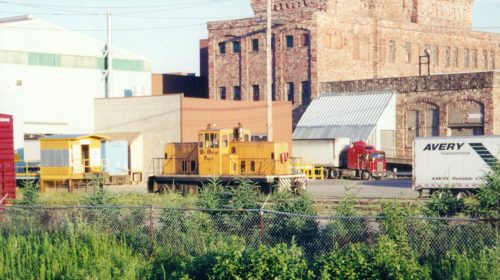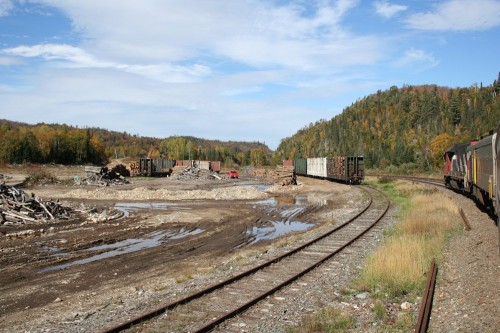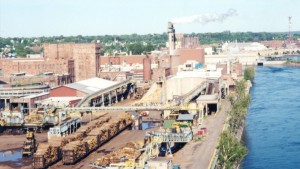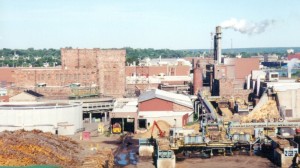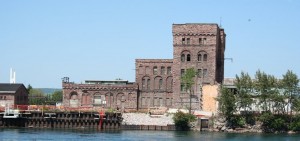Tag Archives: St Marys Paper
Paper traffic on the ACR
The primary source of paper traffic on the ACR was of course the old St. Marys Paper mill in Sault Ste. Marie. The original pulp mill dates back to the 1890s, and through a couple of name changes and significant expansions over the years, lasted until 2007 when the mill was shut down for good. The mill buildings, except for surviving parts of the original 1890 mill have since been demolished.
Despite having exclusive access to serve the paper mill, the Algoma Central rostered no boxcars for this service. Instead, as pretty much all of the mill’s output was exported south to the US, empty cars were provided by Canadian Pacific and SOO Line, and later primarily by Wisconsin Central.
St. Marys performed their own in-plant switching with their own engine, exchanging cars with the Algoma Central via several interchange tracks at the north west end of the property. ACR yard jobs would then accordingly deliver the cars to the CP/SOO interchange tracks.
In addition to the St. Marys mill in Sault Ste. Marie, additional paper traffic would also travel over the ACR from mills on the CN at Kapuskasing and Smooth Rock Falls and the Ontario Northland at Iroquois Falls bound for mid-west US destinations. Any westbound traffic that might have come these locations for central Canada or the west coast may have also traveled over the ACR from Hearst to Oba to continue westward on the CN main line.
Pulpwood and log traffic on the ACR
Pulpwood (that is, raw logs of a grade and size suitable for use at a paper or pulp mill) has been a staple of the ACR’s traffic since it first began construction in 1899. Large amounts of pulpwood were shipped to the paper mill in Sault Ste. Marie and much exported to mills in northern Michigan and Wisconsin as well.
Before I continue, I’d like to give a shout out to Bruce Gignac and Reg Fitzpatrick, former ACR employees who answered a few of my questions here and confirmed some information. Thanks guys!
Newaygo Forest Products
Newaygo Forest Products operated large pulpwood cutting operations north of Hawk Junction with large logging operations and loading spurs in the Mosher and Mead areas. Newaygo also had an additional spur at Trembley, just west of Wawa on the Michipicoten subdivision. Logs from Newaygo spurs were mainly shipped south for export to paper mills at Appleton and Neenah, Wisconsin.
In 1974 Newaygo established a modern sawmill at Mead to produce lumber and woodchips. While this mill was in operation, most of Newaygo’s pulp log traffic was now sent here to be turned into woodchips for export to Wisconsin (more on that later) instead of sending the raw logs south from Mosher. Logs cut around Mead were also processed at the new mill, and a couple of previously listed Newaygo spurs north and south of Mead were removed from the timetable in the late 1970s.
During the 1960s while logs were being loaded for shipment south to the US, most of the export log loading at Mosher was done at the Mosher north spur, at mile 218 (connecting to the house track and siding). After 1974, with logs being shipped north instead to Mead, most loading was done on the Mosher south spur at mile 217.3 just south of Mosher station.
Some logs from Mosher were also sent to the J.D. Levesque plywood mill in Hearst.
Reg Fitzpatrick also mentioned another interesting occasional movement of pulpwood from Mosher in the 1980s. Using privately owned pulpwood cars provided from Kimberly-Clark in Terrace Bay (bearing KCWX reporting marks) some pulpwood was sent from Mosher via Franz to Ontario Paper in Thorold, ON in southern Ontario’s Niagara Penninsula region. Apparently up to 15-20 cars at a time would be loaded for this service, but only three or four times a year (roughly 60 cars/year). Occasionally a rejected load from the paper mill would be sent back to the ACR and these would be sent to Dubreuilville. (Interestingly, some of these same cars were later purchased and assigned to the ACR by Wisconsin Central in the late 1990s.)
Newaygo shut down the mill at Mead and most of their other operations in Algoma County in 1985.
Abitibi Paper (later St. Marys Paper)
Providing pulpwood to the pulp mill established in Sault Ste. Marie in the 1890s by industrialist Francis Clergue (who also developed much of the other early industry in the Sault including the railway, hydro-electric power company and Algoma Steel) was pretty much the reason the line was originally driven into the forests north of the Sault. Originally a component of Clergue’s Consolidated Lake Superior Corporation, in later years the mill was operated by Abitibi Pulp and Paper, and later independently as St. Marys Paper. Its fortunes declining, the mill closed down for good in 2007 and has since been demolished, except for some of the original heritage structures from the late 19th century.
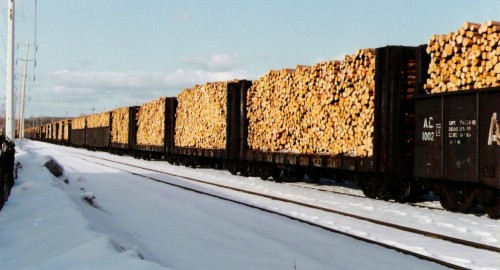
A southbound freight arrives at Steelton yard in the early 1980s with a significant amount of pulpwood, likely for the Abitibi Paper mill. Morgan Turney photo.
Several different spurs owned and operated by St. Marys Paper are listed in the official employee’s timetables, with notable operations at or near Millwood (just north of Agawa siding), Limer and Trembley. This however, doesn’t necessarily tell the whole story, as quite often pulpwood was also loaded at the house track at several different sidings along the line, and this wouldn’t be additionally listed in the timetable. Batchewana, Mekatina, Regent and Frater are a few sidings definitively known to have hosted significant pulpwood loading operations, usually by private contractors but in many cases shipping to St. Marys Paper.
Other
In addition to Newaygo and St. Marys Paper, probably the biggest shippers and receivers of pulpwood on the ACR, several other mills on the ACR also received logs by rail.
In Searchmont there was a veneer mill operated by Weldwood Canada (later G.W. Martin). Log spurs operated by the same company were located at Eton. This mill shut down around 1990.
In Sault Ste. Marie there was a lumber & veneer mill operated by Weyerhauser in the early 1980s. (Originally established in 1948 as Roddis Lumber & Veneer, and sold [by Weyerhaeuser] to G.W. Martin in the mid 1980s, and later to Lajambe Forest Products, Agawa Forest Products (E.B. Eddy) and Domtar, and still operating today as Boniferro Mill Works). This mill likely received logs from a few locations, and there was a Weyerhaeuser spur at Achigan (mile 42) during the early 1980s (spur listed under G.W. Martin in the late 1980s). I’ve seen a number of photos such as the one below with loads of larger logs, mostly shot in or near Sault Ste. Marie. I’m guessing that the Weyerhaeuser mill is a likely destination for these although I honestly don’t know for certain. I’m not sure where these logs are loaded either, but this very nice Dave Beach photo shows that at least some of them come from north of Montreal Falls (mile 92).
After the Wisconsin Central takeover in late 1995 or early 1996 a new oriented strandboard (OSB) mill opened at mile 153 north of Perry siding. Video and photos that I’ve seen do show that logs were shipped here by rail in AC flatcars, but I’m not sure where from. This mill closed sometime around 2007 due to the general decline in the northern Ontario forestry industry in the early 21st century.
The sawmill at Dubreuilville did not general receive much in the way of logs by rail, as their cutting rights were close to their mill and mostly delivered by truck.
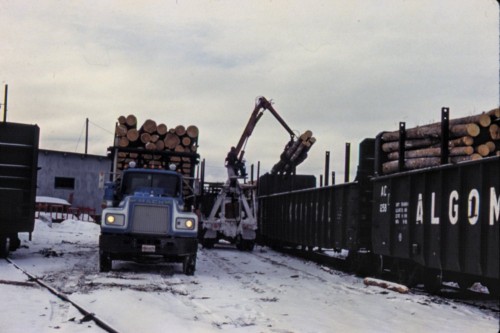
Loading pulpwood on the team track behind the freight shed at Hawk Junction, March 1981. Photographer unknown, slide in my collection.
In addition to isolated spurs owned or operated by specific companies as above, there are several smaller logging companies that show as operating their own spurs – these smaller companies would likely have sold their logs to the area mills in Searchmont, the Sault or Michigan. Also as mentioned above in the St. Marys Paper section, a lot of pulpwood was loaded at house tracks at various locations and wouldn’t be reflected in the “Loading Spurs” section in the timetable.

Pulpwood flatcar owned by Besse Forest Products. Besse operated a loading spur beside Steelton Yard in the early 2000s for export pulpwood. At Sault Ste. Marie in August 2004. My photo.
Columbia Forest Products was another company that had a pulpwood loading operation on the ACR’s property behind the Steelton car shops in the late 1990s and early 2000s; Columbia also operated the plywood mill in Hearst from 1995, and presumably these logs loaded in Sault Ste. Marie would have been shipped north over the railway to the mill.
Operations Today
Today the paper mill at Sault Ste. Marie and various forest products mills at Searchmont, Limer, Dubreuilville and Mead are all closed, but there is still some loading of pulpwood for export to Michigan and Wisconsin.
When I rode the tour of the line to Hearst in 2013, I noted active operations at Odena (mile 10), Eton (mile 120) and Langdon (mile 240, just south of Oba). This summer I also heard southbound freight 574 on the radio doing some switching of log spurs at or near Regent siding (mile 89).
There’s also some current movements of pulpwood from one of the spurs/sidings (not sure which) on the former ACR to somewhere in Quebec (I’ve not yet been able to determine exactly where these are going). These travel up to Hearst where they are routed over the Ontario Northland into Quebec via Rouyn-Noranda.
Also, across town at the Huron Central yard, pulpwood is loaded for shipment to the Domtar mill at Espanola. While this is not really related to the ACR per se, I’m not sure if logs for this mill were also loaded at locations along the ACR at times as well.
St. Marys Paper, Then and Now
The old paper mill in Sault Ste. Marie, one of the original industries in town and an ACR customer for over a century, has recently closed down, and when I visited Sault Ste. Marie in July, the mill was in the process of being demolished. Fortunately I have some good photos of the mill from some previous visits to the area, so in this post we’ll look at the last 20 years of the mill’s operation.
All photos below taken by myself unless otherwise noted.
Note: this is the last in a series of posts covering specific locations on the ACR based on photos taken taken on my July trip to the former ACR.
THEN:
St Marys Paper in 1992 from the International Highway Bridge:
Plenty of stockpiles of pulpwood logs fill much of the open ground on the property. Plenty of Wisconsin Central boxcars await paper loading. (This shot is before the WC takeover of the AC, but much of the mill’s output was exported to the US.)
And a few more views from 2000:
Those flatcars in the first photo in this set are most definitely former AC 2301-2373 series 40′ flatcars; these are likely owned by the paper mill and used for moving pulpwood logs around from stockpiles on the property. Note in the foreground of the 1992 photo above a pair of 48′ gondolas with similar home-made end racks.
This photo shows what looks to be the log debarking and chipping machinery. A covered pipe or conveyor brings the chips into the pulping mill. Note the switcher poking out of the building at centre.
We can see from this last photo that the water treatment facility has been expanded since the 1992 shot. The tracks running roughly through the foreground head towards the paper loading warehouse off to the left, out of frame.
And here’s one of the mill switchers resting behind the mill, near the warehouse/shipping building. I wonder what’s become of this engine now? Sold to a new owner when the mill closed, or just scrapped along with any other rail equipment at the mill?
And one last photo from 2004, taken from across the power canal. Compare this last one especially to the photos below.
NOW:
Closed sometime within the last few years, the mill is now being demolished. Everything but the remaining original sandstone structures has just about been torn down in these July 2013 photos. It appears that the original structures are being deliberately preserved for now due to their heritage nature, as they are over a century old. First three shots taken from across the power canal.
From the front of the mill, we can see that the main mill buildings, except for the remaining original sandstone structures, have been completely torn down, and the modern steel warehouse/shipping building at right is the last structure to go. It’s not obvious from this angle, but the back half of that structure is already gone and it’s definitely in the process of coming down.

